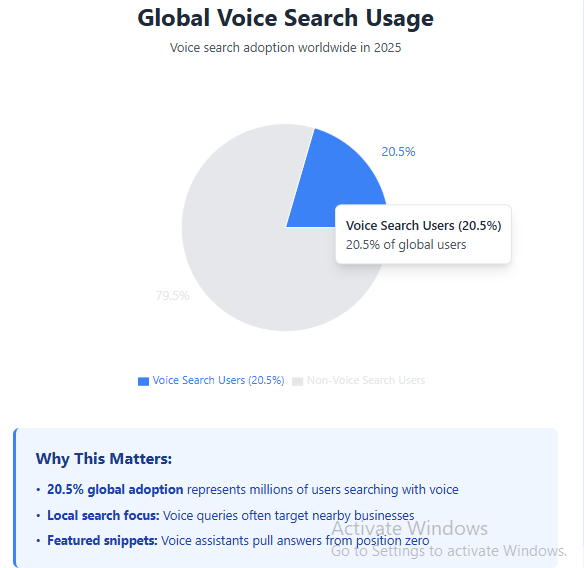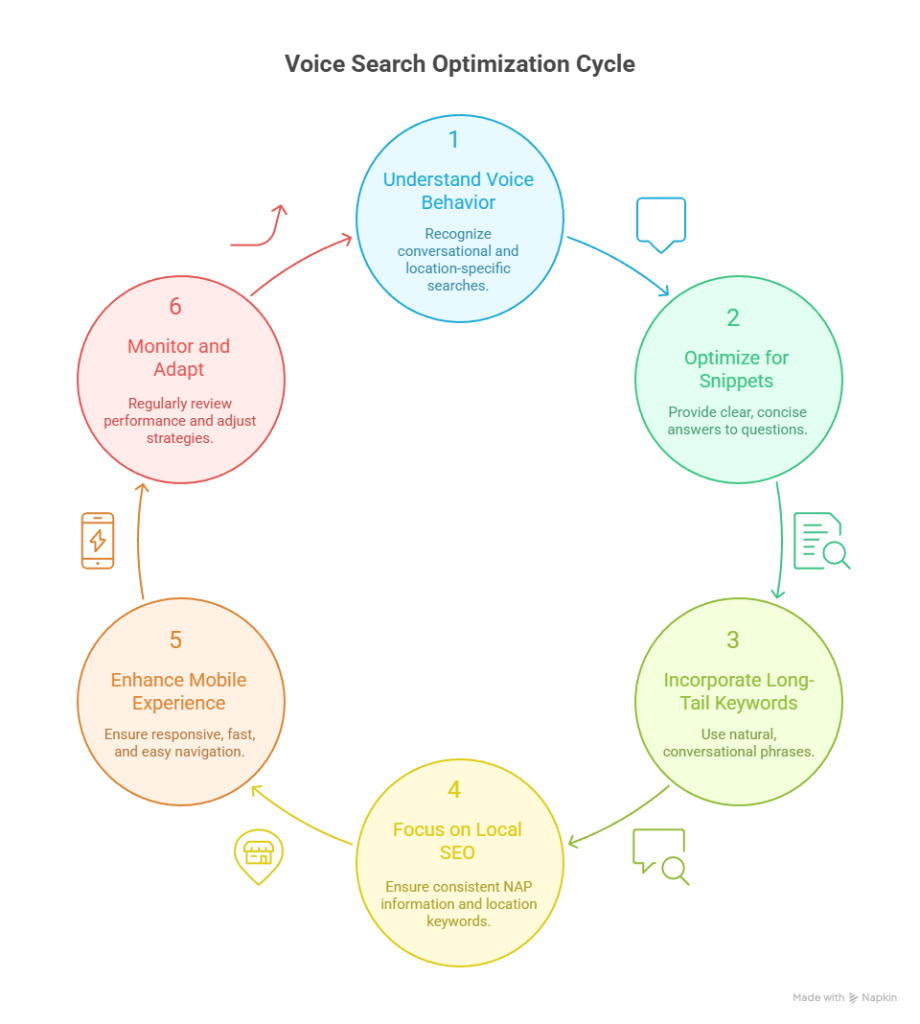Learn how voice search optimization can boost your website traffic and visibility. Discover strategies for local SEO, mobile optimization, and featured snippets to stay ahead in digital marketing.
How To Use Voice Search Optimization To Get More Traffic
I believe the key to driving more traffic with voice search is speaking your audience’s language. Voice searches are conversational and often phrased as questions, like “What are the best coffee shops near me?” rather than short keywords. By writing content that mirrors this natural speech, you increase the chances of being discovered.
Targeting local searches is equally important. Most voice searches have local intent, so keeping your business’s name, address, and phone number consistent across Google Business Profile and directories helps attract nearby customers. Including location-specific phrases naturally within your content also boosts visibility.
I also focus on mobile optimization, as most voice searches occur on smartphones. Fast-loading, responsive websites with clear navigation enhance user experience and improve rankings. Featured snippets are another goldmine: concise, direct answers make it more likely that voice assistants will read your content aloud.
Finally, I constantly analyze and tweak my strategy. Tracking which conversational keywords drive traffic allows me to refine my content and stay ahead. Combining conversational content, long-tail keywords, local focus, mobile optimization, and snippet targeting ensures I get more relevant traffic through voice search.
What is voice search optimization?
Voice search optimization is the process of tailoring your digital content to align with voice-based search queries. Unlike traditional text searches, voice searches are more conversational and often longer. For instance, a user might say, “What are the best Italian restaurants near me?” instead of typing “best Italian restaurants.” Recognizing this shift is crucial for businesses aiming to enhance their online visibility.
How does voice search work?
Voice search operates through voice recognition technology, which converts spoken words into text. This text is then processed by search engines to provide relevant results. The accuracy and efficiency of voice search have improved significantly with advancements in artificial intelligence and natural language processing.
Why optimize for voice search?

Global Voice search Optimization
Optimizing for voice search is becoming increasingly important in digital marketing for several reasons:
- Increased Usage: As of 2025, approximately 20.5% of people globally use voice search, indicating a growing trend towards voice-based queries.
- Local Search Relevance: Voice searches often have local intent, with users seeking nearby businesses or services.
- Featured Snippets: Voice assistants frequently pull answers from featured snippets, making it essential for businesses to optimize their content for these positions.
Voice Search Statistics 2025 (Key Highlights)
- Around 20.5% of people worldwide use voice search.
- Around 8.4 billion voice assistants are expected to be in use globally.
- In the United States, 153.5 million people are expected to use voice assistants.
- Siri has 86.5 million users in the United States.
- Approximately 27% of people use voice search on their mobile devices.
- In the U.S., 38.8 million people (13.6% of the population) use smart speakers for shopping-related activities.
- “Near me” and local searches make up 76% of voice searches and are expected to grow as more people use voice search to find local businesses.
How to optimize for voice search
Use a conversational tone
When creating content, adopt a natural, conversational tone. This approach mirrors the way people speak, making it more likely that your content will match voice search queries. For example, instead of stating, “Our restaurant offers a variety of Italian dishes,” say, “What Italian dishes do you offer?”
Include more long-tail keywords
Voice searches tend to be longer and more specific. Incorporating long-tail keywords that reflect natural language can improve your chances of appearing in voice search results. For instance, instead of targeting “Italian restaurant,” aim for “best Italian restaurant with outdoor seating in downtown.”
Target local searches
Since many voice searches are location-based, it’s vital to optimize your content for local SEO. Ensure your business’s name, address, and phone number (NAP) are consistent across all platforms. Additionally, include location-specific keywords in your content to attract local customers.
Optimize your site for mobile search.
Mobile devices account for a sizable percentage of voice searches. Therefore, ensuring your website is mobile-friendly is essential. This includes having a responsive design, fast loading times, and easy navigation.
Earn featured snippets
Featured snippets are concise answers displayed at the top of search results. To increase your chances of being featured, provide clear and direct answers to common questions related to your business. Use structured data to help search engines understand your content better.
Flowchart: Steps to Optimize for Voice Search

Flowchart: Steps to Optimize for Voice Search – visual selection
- Understand Voice Search Behavior: Recognize that voice searches are conversational and often location-specific.
- Optimize Content for Featured Snippets: Provide clear, concise answers to common questions.
- Incorporate Long-Tail Keywords: Use natural, conversational phrases that reflect how people speak.
- Focus on Local SEO: Ensure your business’s NAP information is consistent and includes location-specific keywords.
- Enhance Mobile User Experience: Ensure your website is responsive, fast, and easy to navigate.
- Monitor and Adapt: Regularly review your voice search performance and make necessary adjustments.
How Do I Optimize My Business for Voice Search?
To effectively optimize your business for voice search, it’s essential to focus on several key areas:
- Claim and Optimize Your Google Business Profile: Ensure your business information is accurate and up-to-date. This includes your name, address, phone number, business hours, and services offered. A well-maintained profile enhances your visibility in local voice search results.
- Incorporate Conversational Keywords: Voice searches are typically more conversational and longer than typed queries. For instance, instead of targeting “best pizza,” aim for “What are the best pizza places near me?” Integrate these natural language phrases into your content to align with voice search patterns.
- Focus on Local SEO: Many voice searches have local intent. Ensure your website includes location-specific keywords and that your business is listed in local directories. This helps in appearing in “near me” voice search results.
- Enhance Mobile User Experience: Since a significant portion of voice searches occurs on mobile devices, ensure your website is mobile-friendly. This includes having a responsive design, fast loading times, and easy navigation.
- Utilize Structured Data: Implementing schema markup helps search engines understand your content better, increasing the chances of your business being featured in voice search results.
By focusing on these areas, you can improve your business’s visibility and ranking in voice search results.
Is Voice Searching the Future of SEO?
Yes, voice searching is increasingly becoming a significant aspect of SEO. As of 2025, approximately 20.5% of internet users globally utilize voice search, with a notable increase in daily usage.This trend indicates a shift in user behavior towards more natural and conversational search methods.
The rise of smart speakers, virtual assistants, and mobile devices has contributed to this change. With more users relying on voice commands for information retrieval, businesses must adapt their SEO strategies to accommodate this shift.
Optimizing for voice search involves focusing on natural language processing, long-tail keywords, and local SEO. By aligning your content with how users speak, you enhance your chances of appearing in voice search results, thereby improving your SEO performance.
How Do You Rank on Voice Search?
Ranking on voice search requires a strategic approach that includes the following steps:
- Target Featured Snippets: Voice assistants often pull information from featured snippets. To increase your chances of being featured, provide clear and concise answers to common questions related to your business.
- -based voice-based-based Optimize for Local Intent: Many voice searches have local intent. Ensure your content includes location-specific keywords and that your business is voice-based and listed in local directories to appear in “near me” voice search results.
- Improve Website Performance: A fast-loading, mobile-friendly website enhances user-based voice experience and is favored by search engines, improving your chances of ranking in voice search results.
- Use Structured Data: Implementing schema markup helps search engines understand your content better, increasing the likelihood of your business being featured in voice search results.
- Monitor and Adapt: Regularly analyze your voice search performance and adjust your strategies as needed to maintain and improve your rankings.
By implementing these strategies, you can enhance your visibility and ranking in voice search results.
conclusion
In conclusion, optimizing for voice search is no longer optional; it has become a vital aspect of digital marketing for businesses aiming to stay competitive. With the rapid rise of voice-activated devices and the shift toward conversational, hands-free searches, companies must align their SEO strategies with how people actually speak.
By understanding voice search behavior and implementing strategies like conversational content, long-tail keyword optimization, local SEO, mobile-friendly design, and featured snippet targeting, businesses can enhance their online visibility and attract more relevant traffic. According to recent statistics, over 20% of online searches are now conducted via voice, a number expected to rise steadily in the coming years.
Investing in voice search optimization not only improves search engine rankings but also enhances user experience, builds trust, and positions your business for future growth. According to me, businesses that embrace voice search today will be better equipped to thrive in a digital world where voice-first interactions are increasingly becoming the norm.
FAQS
1. What role does voice-search optimization play in shaping the future
of digital marketing strategies?
a. Voice search is changing how people search online and is becoming key to data-based marketing. Instead of short keywords, users ask full questions, so companies must create natural, conversational content. It also boosts local SEO, as most searches are “near me.” Answers often come from featured snippets, so being clear and concise helps brands stand out. In short, voice-search optimization helps businesses stay visible, engage better, and adapt to a voice-first world.
2. What’s the most overlooked factor when optimizing for voice search?
a. The most undervalued aspect is conversational intent and natural questioning. Voice searches are longer and question-like, such as “What are the best coffee shops near me in New York City?” instead of “best coffee shops NYC.” To be effective, content must follow a Q&A style, use natural language, aim for featured snippets, and target local intent. Success means thinking about how people talk, not how they type.
3. What Are the Key Steps to Make Content Voice-Search Friendly?
a. To make content voice-search friendly, use conversational language and question-based FAQs. Keep answers short for featured snippets and optimize for local searches with “near me” keywords. Ensure your site is fast, mobile-friendly, uses structured data, and has simple formatting. In short, voice optimization means talking like humans, giving direct answers, and maintaining strong technical SEO.
4. How do you keep your brand voice consistent across multiple channels?
a. Keeping your brand voice consistent requires a clear brand voice guide for tone, style, and language. Everyone creating content should follow it. Adjust the voice for each platform without changing the brand’s personality. Regular reviews ensure audiences recognize and trust your brand everywhere.
5. How do you approach voice search optimization for local businesses?
a. For local businesses, focus on local intent since most voice searches are location-based. Optimize Google Business Profile, ensure correct NAP info, and use keywords like “near me.” Create conversational, question-based content on services and directions. Good reviews, schema markup, and a fast, mobile-friendly site help reach customers searching hands-free.
